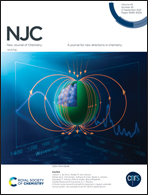High-capacity and superior behavior of the Ni–Cu co-doped spinel LiMn2O4 cathodes rapidly prepared via microwave-induced solution flameless combustion
Abstract
A simple and rapid microwave-induced solution flameless combustion method to prepare high-capacity Ni–Cu co-doped spinel LiMn2O4 is provided in this work. Ni–Cu co-doping effectively reduces the lattice parameters and Jahn–Teller effect of the spinel LiMn2O4 to obtain a more stable crystal structure. The microscopic morphological characteristics clarify that the growth and development of grains is significantly controlled by microwave treatment and Ni–Cu co-doping. The optimized LMNCO-0.050 electrode exhibits a higher initial discharge capacity of 128.1 mA h g−1 than the un-doped LMO electrode of 120.6 mA h g−1 at 1 C and room temperature. In particular, the LMNCO-0.050 electrode achieves high initial discharge specific capacities of 111.3 and 106.8 mA h g−1 at high rates of 5 C and 10 C, corresponding to excellent retention rates of 70.89% and 77.43% after 1000 cycles. Moreover, the excellent retention of 41.89% of the LMNCO-0.050 electrode after 1000 ultra-long cycles at 55 °C and 1 C can be attributed to the improved structural stability of the LiMn2O4 by Ni–Cu co-doping.



 Please wait while we load your content...
Please wait while we load your content...